A Voyage to Sicily
The Decorative Arts Trust’s upcoming tour of Sicily will be the first time the organization has gone there, but the island has been a travel destination for centuries. This post presents a selection of images and translated texts from one of the first travel guides for Sicily, a copy of which is available in the rare books collection of the Winterthur Library, the monumental series Voyage Pittoresque ou Description des Royaumes de Naples et de Sicile, by the French noble and amateur artist Jean-Claude Richard de Saint-Non. Many of the sites described in his book will be enjoyed by trust members come October.
Due to its central location in the Mediterranean basin, Sicily has been at the confluence of several cultural and political influences throughout it’s history, including classical Greek and Roman civilizations, Carthaginian invasion from North Africa, rule by Vandals, Ostrogoths, Byzantines, Arabs, and Normans after the fall of the Roman empire, and personal union to the Spanish monarchy in Saint-Non’s day.
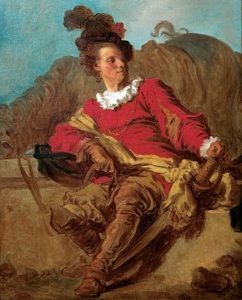
Jean-Claude Richard de Saint-Non (1727-1791), painting by Jean-Honore Fragonard, Museu Nacional d’Art de Catalunya.
In 1785, Saint-Non sent the fourth and final volume of Voyage Pittoresque to publication. The project began thirty-six years earlier in 1759, when he traveled with his friends Jean-Honoré Fragonard and Hubert Robert down the Italian peninsula into the Kingdom of Naples, spending a great deal of time at the excavations of Pompeii and Herculaneum. Upon his return to France, Saint-Non determined to produce an illustrated record of his travels, using the sketches and paintings the three artists made as guides for etchings depicting significant buildings, ruins, and views of the countryside. Subsequent trips up until 1780 provided more material and more views.
Although he was listed as author, Saint-Non served more like an executive editor, incorporating travel accounts acquired from other sources. For Sicily in particular, he incorporated descriptions and illustrations supplied by the commander of the sailing vessel Dolomieu, who had traveled extensively in the Val di Noto region. Likewise, Saint-Non enlisted the best artists and printmakers of his day to produce the illustrations, although many of his own works appeared in the volumes as well. It was the most ambitious privately published book of its era, eventually consuming Saint-Non’s personal fortune, and then those of his brothers.
Despite being a financial flop, Voyages Pittoresque became the forerunner of a genre of books, which were often referred to as “Voyages Pittoresque” because of their titles. These lavishly illustrated travelogues recounted journeys to remote or exotic locales. Categorizing southern Italy and Sicily as remote may register as unusual to modern ideas of accessibility, but Saint-Non lived in an age of political unrest and few good roads. That the same man ruled the same territories of Naples and Sicily as Ferdinand IV, the III, and the I (in that order), perhaps best illustrates the uncertainty of the era.
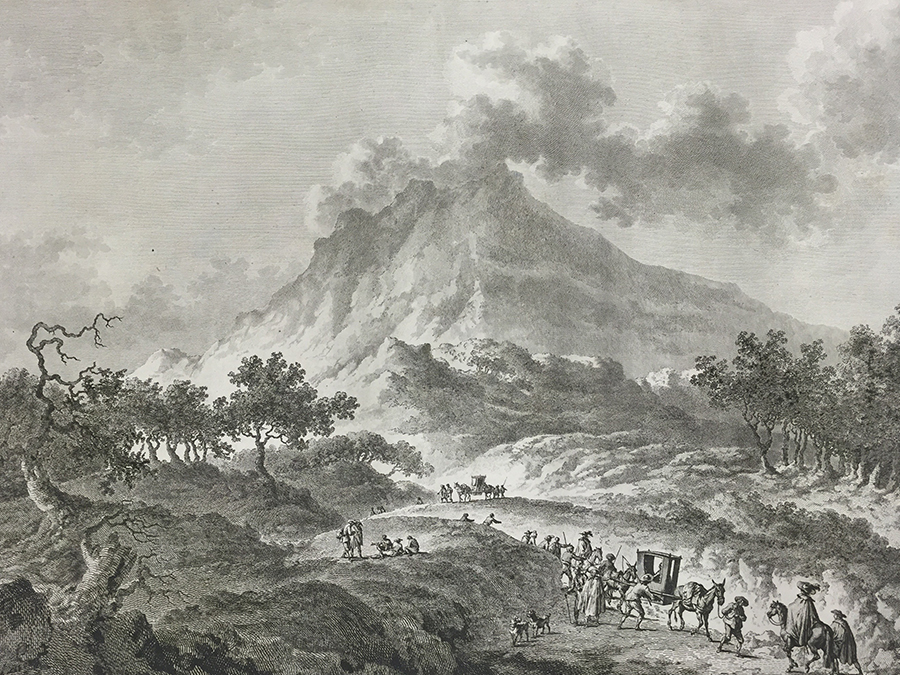
“View of Etna from the Woods,” etching by Allix. Courtesy, The Winterthur Library: Printed Book & Periodical Collection.
Southern Italy also happened to be in a period of geological turmoil, with Mount Vesuvius erupting thrice during Saint-Non’s work on the publication, and a series of earthquakes and tsunamis destroying the cities and towns, including Messina in 1783. Risks of volcanic incineration aside, Saint-Non’s travelogue appealed to the 18th century hunger for landscapes and the growing delineation between rational and non-rational experience of aesthetics.
Palermo
Sicily being an island, many of the main cities are ports or harbors, including Palermo, which was Saint-Non’s first stop. He enjoyed remarking on the geography, and how it had changed since ancient times.
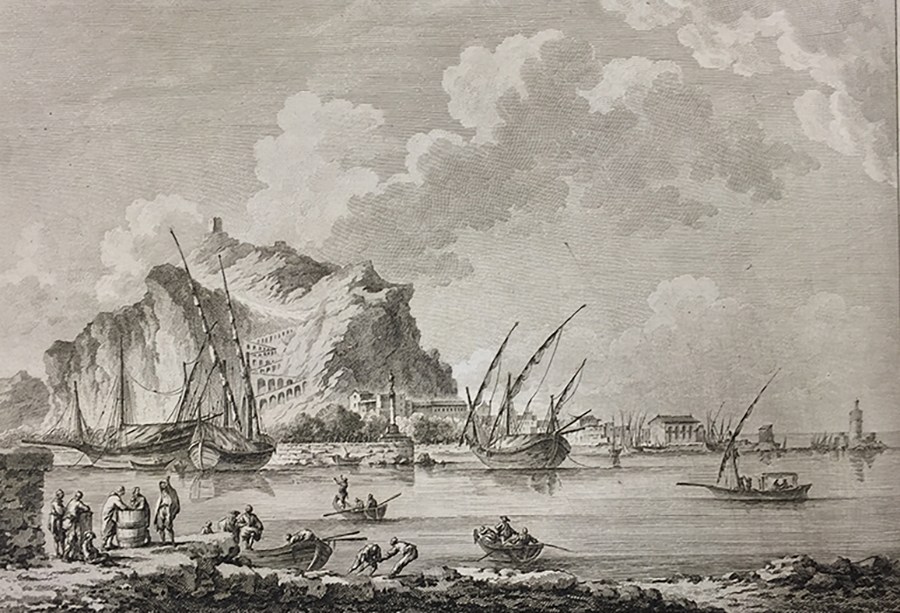
“First View of Palermo,” drawn by Chatelet, engraved by Paris. Courtesy, The Winterthur Library: Printed Book & Periodical Collection.
Palermo is entirely different from what it formerly was. One no longer finds the Panormos of antiquity, although the location is still the same. This city was initially separated into three parts. The middle, which is the most ancient, was called Panormos by the Greeks, and in Latin Totus Portus, or Port of All Nations. It almost stood on an island, surrounded on one side by the sea, which advanced westward via a canal following the city walls, and on the other by the Oreto River, which after running for some distance through a pleasant valley in the foothills of the mountains, bordered the city on the southern side.

“Second View of Palermo,” drawn by Desprex, engraved by du Parc. Courtesy, The Winterthur Library: Printed Book & Periodical Collection.
Beyond the river, a suburb named Neopolis, or New City, formed the second part of ancient Panormos. The Romans encircled this part with palisades when they took the city from the Carthaginians during the First Punic War in the Roman year 499. Finally the ancient city was again an inland port that, by the canal and the riverbed, received the vessels of the day in its very center, and nearly all around the walls of the old city. Nothing remains of this ancient port save for a small bay filled with Sicilian barques, and a few other vessels which one dares to leave out in winter due to the North wind that would blow them aground. This bay, as well as Palermo, is situated at the base of a gulf formed by Cape Lazarano, Mount Catalfano, and the undulating hills of Mount Ereto, today known as Mount Pellegrino.
Temple della Concordia
Saint-Non and his companions, like many of their contemporaries, were fascinated by ancient and antique ruins. They spent a great deal of time in the vicinity of Agrigento in the “Valley of the Temples,” which, inexplicably, is located on a hill overlooking the city.
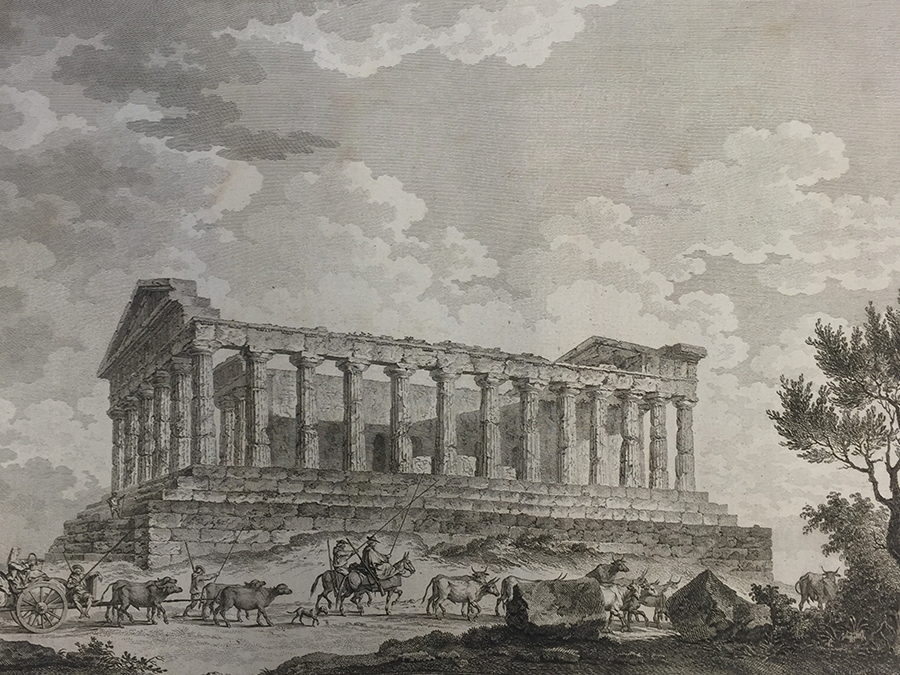
“Lateral view of the Temple della Concordia,” drawn by Berthault, engraved by de Ghendt, Courtesy, The Winterthur Library: Printed Book & Periodical Collection.
From the Temple of Juno, we passed to the Temple of Concord, the most intact of the monuments of Sicily, and the only one to have been maintained. It is in the same direction as the first, placed the similarly, near and under the walls of the old city, and built to the same plan, with the exception of the bedrock, which is not as elevated, and the lateral walls of the interior of the temple where each side has six centered doors.

“View of the Temple della Concordia,” drawn Masquelier, engraved by de Ghendt. Courtesy, The Winterthur Library: Printed Book & Periodical Collection.
From the Temple of Concord, we followed the ancient walls of the city, of which there only remains a section placed on the same rock, it survived as the base and foundation of the famous murals so vaunted that Virgil mentioned his heros viewing them, it is true, long before they were actually built, which was not until after the battle of Imera by the Carthaginian prisoners taken then, under the reign of Theron, and when Gelon reigned in Syracuse. These times were well after the voyage of Aeneas, but perhaps he would have talked about the Castle of Cocalus, built, as we have said, on the top of the mountain today known as Girgenti.
Agrigento
Like many well-born and educated travelers, Saint-Non turned to classical authors and historians for information about the sites he described, some of which were true to history and others that had become distorted by the passage of time. By and large, he was able to stick to the facts although he occasionally offered his own opinions. With the ongoing excavations of Roman sites on the Italian peninsula bringing that era of history to greater attention, the ancient temples, quarries, and other buildings in the vicinity of Agrigento proved of great interest to Saint-Non, and he spent the majority of his volume on Sicily describing them.

View of the Rocks which surround the ancient city of Agrigento, drawn by Duplessis Bertaux, engraved by Guttemberg.
One of the least changed sites of ancient Agrigento is a region of rock and jagged peaks represented by this engraving. It forms the Rupe Atenea… and is probably the place Polybus had in mind with his description of the city of Agrigento: “The walls and the structures are in a high degree fortified by its excellent natural situation; for the walls are partly the steep, sublime rock itself, and partly the structure imposed thereon.” At the peak of the rock the Temple of Minerva once stood, until it was burned by Gelias, the rich citizen of Agrigento, who retired there with all of his treasure when Imilcon invaded the abandoned city. He had hoped to find asylum there, but upon seeing that the Carthaginian fury held nothing sacred, he set himself on fire in the temple, and burnt it with all its treasure. Nothing remains today of the antique edifice save for a few fragments of the lower bleachers and the foundation of the temple’s atrium. Everything is so fragmented and destroyed, it is impossible to recognize anything, neither its form nor construction.
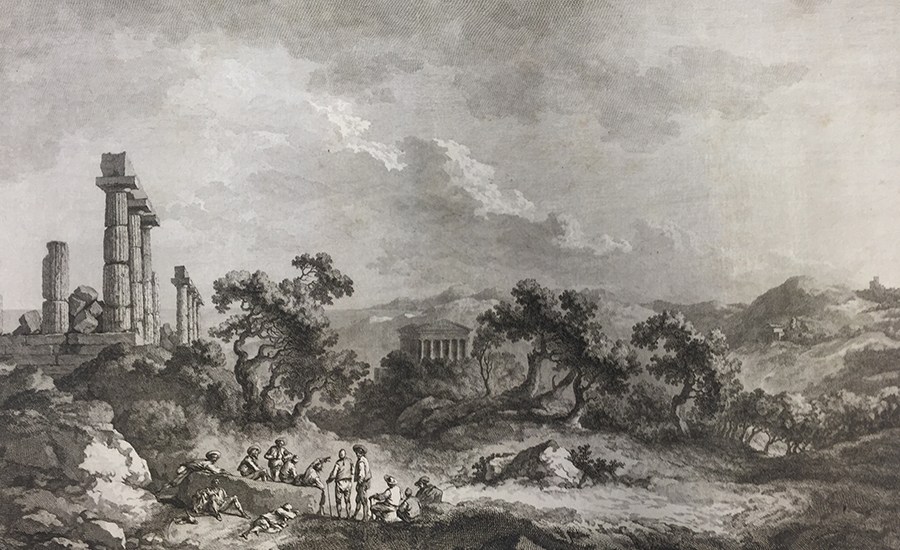
View of the Ruins and Antique Monuments in the vicinity of Agrigento, drawn by Chatelet, engraved by Allix.
From the Temple of Minerva to that of Ceres and Proserpina, one sees only these rocks, of which the slope is so naked and steep that there is every reason to believe it was never covered with houses. It’s not far from the part of the ancient city where one can still find the quarries where the Agrigentines kept the Carthaginian prisoners they took at the Battle of Hymere (480 B.C.), and where the prisoners served by extricating the stones with which the Sicilians built most of their temples.
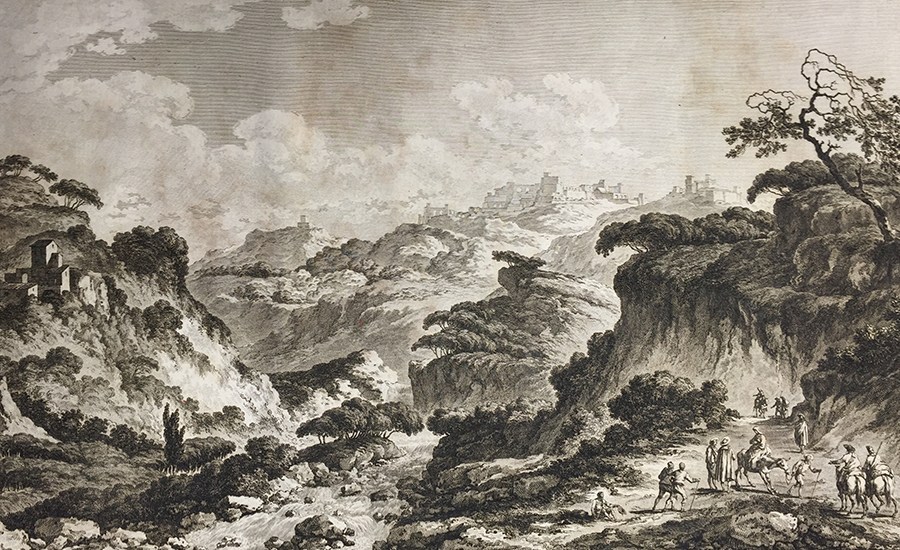
View of the Environs of Girgenti, ancient and celebrated city of Agrigento
These quarries of Agrigento offer little that is of interest save their size. The excavation is now partly cultivated and forms a great enclosure, much like a pool. The reservoirs have now been made into storehouses. The path that leads to the Temple of Ceres and Proserpina, which is the narrowest and steepest of all the paths, is still as it was formerly. It cuts halfway up through the rocks, and there is every reason to believe that this is truly the ancient path, because one can still see traces of the cart wheels which passed along the ascent to the Temple.
Palermo
During Saint-Non’s visit to the city, Palermo’s Metropolitan Cathedral of the Assumption of the Virgin Mary, was just beginning a phase of renovations to add neoclassical elements to the structure. Saint-Non’s illustrations were based on the architect’s drawings of the projected structure, and bore little resemblance to the church he actually saw. The cathedral’s dome, for example was only completed after 1781, after Voyages Pittoresque was published. Like many aesthetes, Saint-Non did not shy from offering pointed commentary on the cathedral’s features, particularly the sometimes discordant relationships between the various building campaigns, which spanned from the Gothic to late Baroque. The appreciation for this visual record of change didn’t truly begin until seventy years later, when John Ruskin delineated between “preservation” and “restoration” in The Seven Lamps of Architecture of 1849.

View of one of the Horse Parades for the Feast of St. Rosalie, near the Cathedral of Palermo, Drawn by Desprez, etched by Berthault.
We arrived in Palermo on July 2, ten days before the famous Feast of Saint Rosalie—an ancient citizen of the city, whose remains were dug up in a grotto of Mount Pellegrino, in the middle of the tombs and gigantic bones of the Saracens buried in the same vicinity. Her remains were happily brought back to Palermo, where they have performed incessant miracles, chief among them the moving to celebration, for five whole days of every year, some of the most grave people of Europe.
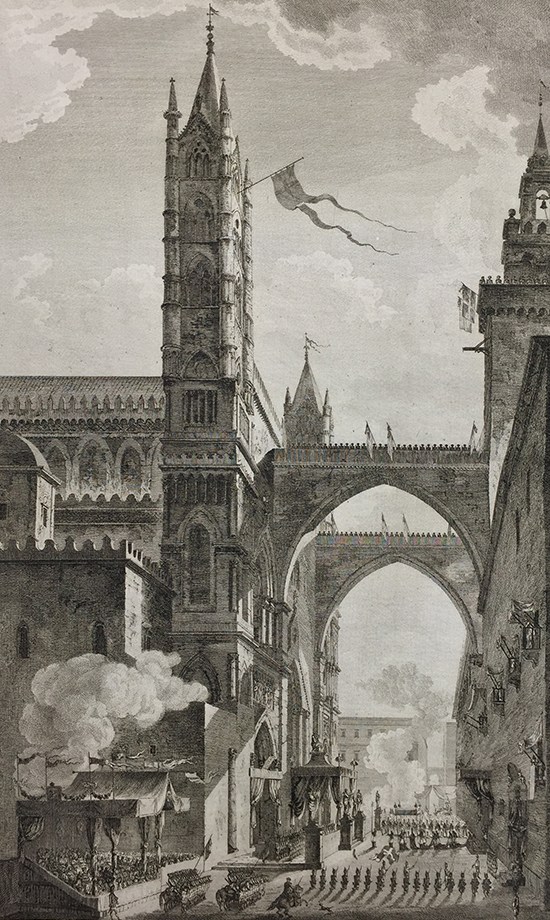
View of the Main Doorway of the Cathedral Church of Palermo, drawn by Desprez, engraved by Quauvilliers.
We first visited the cathedral, “La Matrice,” for thus are called all Cathedrals in Italy. It’s exterior is one of the most beautiful monuments from the twelfth century, particularly for the extraordinary details of its gothic architecture, which are infinite, and give this vast edifice and its surroundings a certain Asiatic character which quite pleased us. The church was built by Gauthier, the Archbishop of Palermo, in the reign of William II. The interior does not quite correspond to the outside. Although the plan is quite beautiful the decoration mixes genres in a manner full of flaws. Each pillar, composed of four short paired columns, bears a gigantic arch surmounted by a large arcade, and ending in a large gateway. The rest of the interior, which threatens to run to ruin, does not gain much by using the same type of column, which already spoiled the first building campaign, and are continuing to spoil the second. They are too short to serve as adequate decoration of a large space, and always hinder any project undertaken. However, as they are of granite, and a great prize in the imagination of the people of Palermo, who absolute want to see them used in this reconstruction, they will be used in the same manner for this rebuilding as they were in the first.
The Decorative Arts Trust will be traveling to Sicily from October 17-25, and again from October 27-November 4. Stay tuned for updates from these study trips!
The Decorative Arts Trust would like to thank Emily Guthrie and Lauri Perkins of The Winterthur Library for their kind assistance during this project.
About The Decorative Arts Trust Bulletin
Formerly known as the "blog,” the Bulletin features new research and scholarship, travelogues, book reviews, and museum and gallery exhibitions. The Bulletin complements The Magazine of the Decorative Arts Trust, our biannual members publication.







